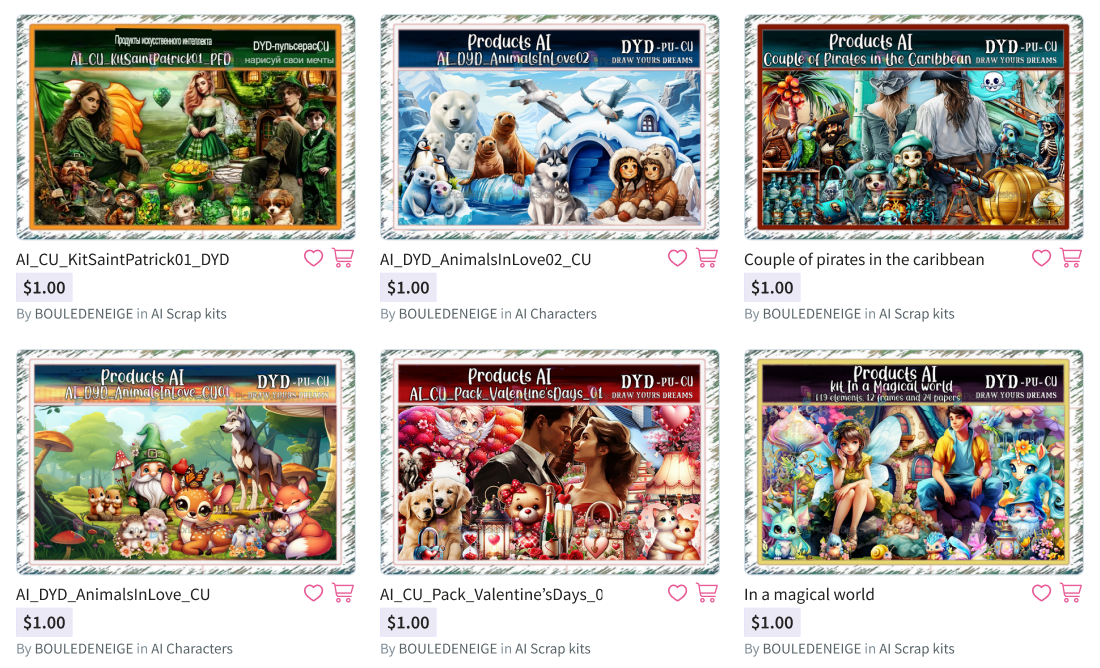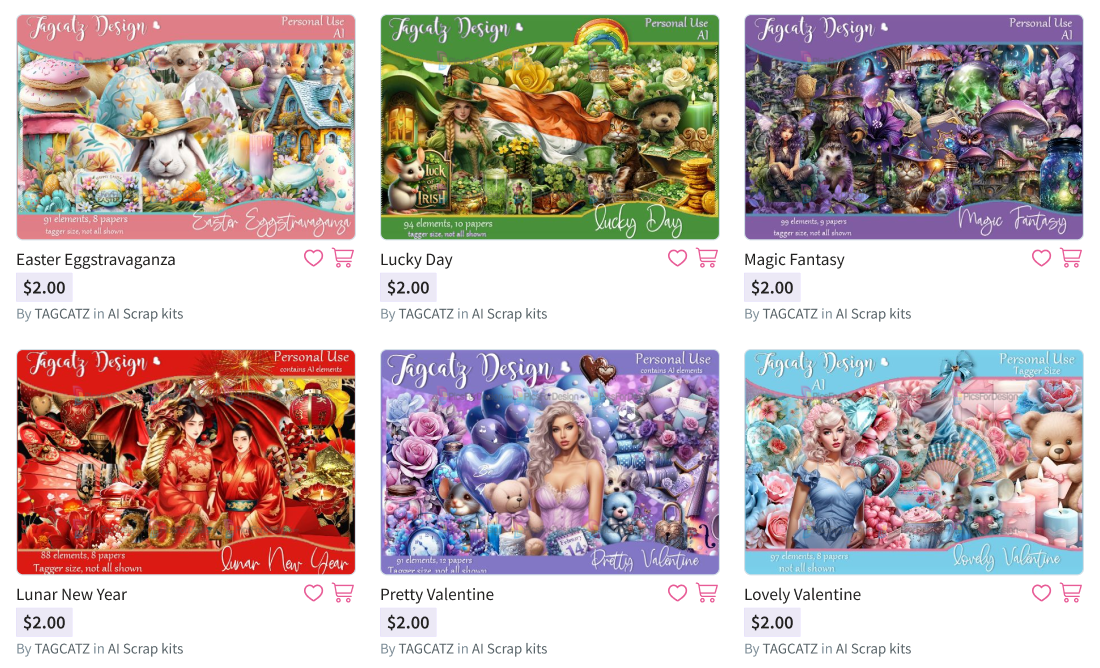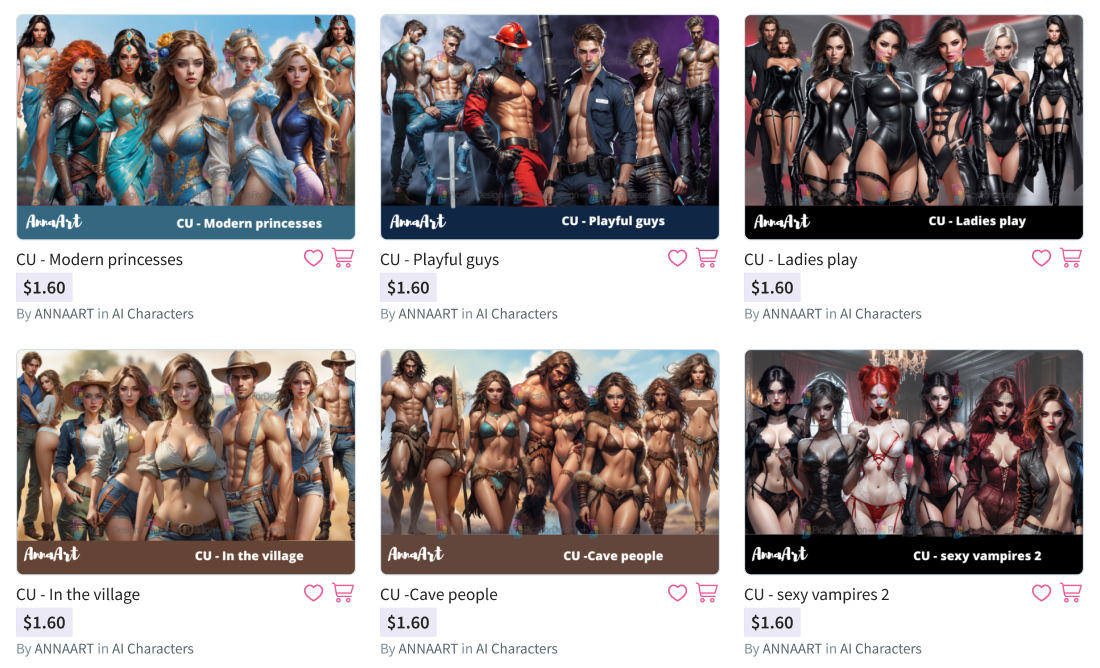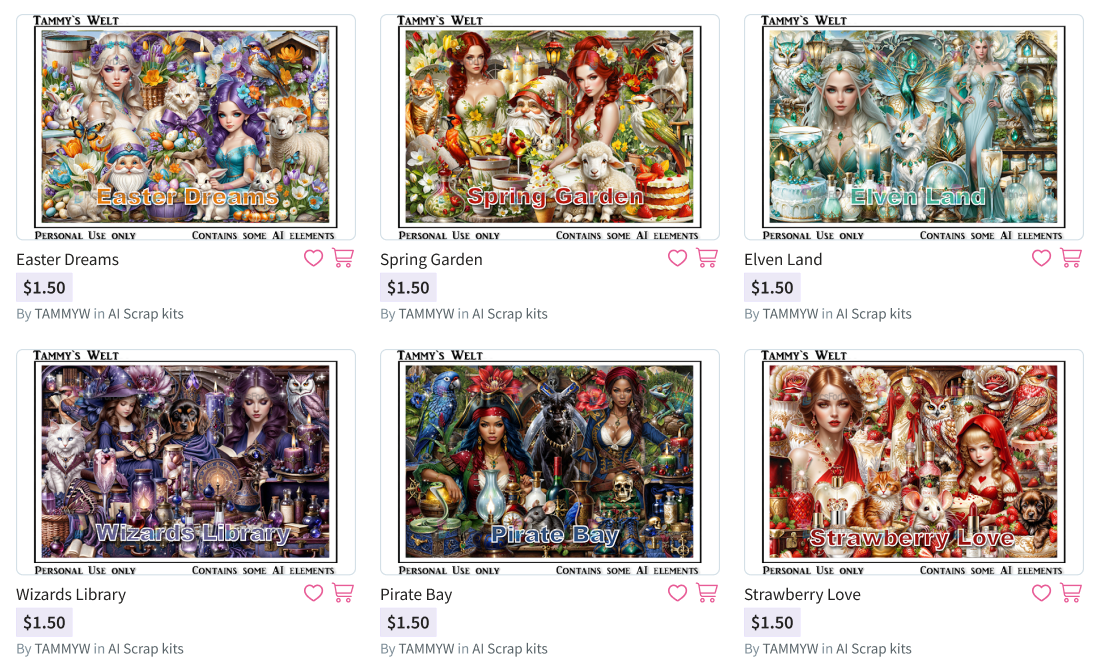|
*PSP tubes is a digital raster multi-layered illustration in psd format, that can be opened in graphic editors such as Adobe Photoshop, Procreate or Corel PaintShop Pro. Hence the name PSP tube. ___________________________ **Scrap kits a set of elements used in digital scrapbooking, or used to create digital cards, social media. ___________________________ ***Poser tubes are 3D drawings created in special programs. |
AI as an Artist: Interviews with Creators
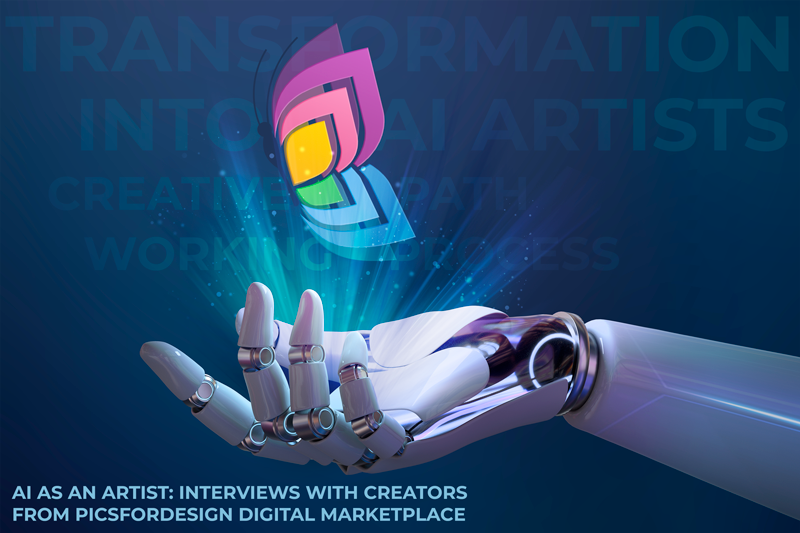
Digital art merges creativity with cutting-edge technology. We delved into this world through interviews with pioneering artists in AI Graphics from PicsForDesign. Explore their work, inspirations, tech use, and vision for digital art’s future. Join us in uncovering the unique perspectives of PicsForDesign artists.
PicsForDesign is a European digital stock platform with over 10 years of experience. Previously, our main section featured PSP Tubes* — semi-realistic character illustrations in PSD format.
In 2023, we launched a new section called Digital Marketplace, where we compiled a wide range of popular categories — from icons to 3D models, vectors, lettering, mockups, and AI Graphics category. Despite our traditional emphasis on manual work, AI Graphics has become prominent in our marketplace, though we strive for balance.
Let’s start by getting acquainted with the artists who were interviewed:
1. Bouledeneige — an artist from San Francisco, working with PFD since 2011. Previously, she worked in the scrap kits** section.
✧ Link to the Scrap Kits store
✧ Link to the store with AI Graphics
2. TammyW:
“My name is Tamara Widitz and I’ve been at PicsForDesign since the end of 2013 my first categories were scrapkits and poser.”
✧ Link to the Scrap Kits store
✧ Link to the store with Poser tubes***
✧ Link to the store with AI Graphics
3. AnnaArt:
“My name is Anna, I’m from Ukraine, currently living in Europe. I have been working with PFD since September 2023. I was introduced to the platform by a friend who has been working there for a year, and I enjoyed watching the artists’ work, so I decided to try it myself.”
✧ Link to the store with AI Graphics
4. Neirohub:
“My name is Lesya Zotova, and I currently live with my family in Montenegro, after moving from Moscow. I have been working with PFD relatively recently. I was invited to the website on Behance via private message at the end of summer. I only use categories for AI graphics.”
✧ Link to the store with AI Graphics
5. Tagcatz:
“My name is Linda, Tagcatz Design.I’m in Ottawa, Canada. I first discovered PFD through another designer, Hania Design. I loved her kits, and at the time I wasn’t making my own, and I went to PFD to purchase them and discovered some other great artists and designers at the same time. I started making my own kits and selling them in Hania’s store. and then in PFD — this would have been about 2010/2011.”
✧ Link to the Scrap Kits store / Hania Store
✧ Link to the store with AI Graphics
Dive into the interviews where the artists share their unique stories, inspiration, and techniques.
◆ 1. How did you start working with AI? What attracted you to AI?
1. Bouledeneige — I discovered AI through various articles on the internet and of course I wanted to test for myself what we could do thanks to this new phenomenon.
2. TammyW — I discovered AI by chance and was immediately fascinated by the many possibilities.
3. AnnaArt — Initially, like many artists, I was against AI until I tried it myself and realized that, first of all, it is an outlet for those who don’t know how to draw but have imagination, and secondly, it’s not as easy as it seems))
4. Neirohub — I started working with AI thanks to my constant interest in news about future technologies and humanity in general. I have worked in IT departments, and I am interested in accessible creative tools. I also love drawing and experimenting with different types of DIY.
5. Tagcatz — My exploration of AI started because I loved the images I was seeing others create and decided I’d like to try it also.
___
◆ 2. What was the turning point that led you to work with AI-based graphics for digital stocks?
1 Bouledeneige — At first, I didn’t really want to use it because its ease of use seemed unfair to artists who take hours to create their article; Then, faced with the rise in AI articles being sold, I started making them too. We can’t do anything against progress!
3 AnnaArt — I love artists very much and often come across them in my work. After getting acquainted with the PFD website and taggers, I really wanted to participate in this creative celebration. AI helped me with this — now I create sets for taggers and receive a lot of positive feedback on Facebook, which inspires me.
___
◆ 3. Do you have any artistic education (or completed courses)? Do you think artistic thinking is necessary when working with AI?
1. Bouledeneige — I have no graphic training. I learned to use the paint shop pro software on my own and over the years, I think I will improve in the graphics field but I am still very far from being a professional….
That said. I don’t think it takes many years of study to use the AI, you essentially have to learn how to make good prompts and therefore vocabulary and above all for the moment know the English language well since the majority of AI software works in English.
4. Neirohub — I don’t have formal art education, only amateur drawing lessons and continuous study of contemporary art. In my opinion, in our postmodern era, classical education is not always necessary or everywhere. Almost anyone can express themselves and attract attention using their unique methods, like street artists, actionists, conceptual artists, videographers.
5. Tagcatz — My past artistic efforts were focused first on acrylic painting, then oils, and now watercolors. I started with folk art painting and more recently am moving toward a loose style of watercolors. I don’t sell my art — it’s simply for my pleasure or for gifts for family and friends. I took courses in all three mediums, but none in digital arts.
I use both traditional graphics and AI in my scrap kits, most of which I purchase from other artists and designers. I’m just beginning to experiment with AI, still exploring the various platforms. I do think you need a creative mind to work with these platforms even if you can’t draw yourself. Imagining what you want, putting it into text and exploring the various models combined with your ideas ends up creating some pretty interesting images! I can see that other designers are creating more complicated and intricate images than I’ve currently been able to achieve, but I’m working on it!
___
◆ 4. What challenges do you face when working with AI tools? Are there any limitations?
1. Bouledeneige — The main challenge is to search for the perfect image that corresponds to our imagination and there are no limits for me.
3. AnnaArt — Sometimes AI doesn’t fully understand my request, but when you work with it for a long time, these problems become less frequent. It’s like “learning the language of AI” and understanding how to explain things better to it.
4. Neirohub — The only challenge in working with AI tools is the inability of the biological brain to keep up with the development of digital technology. Just as you start mastering one technology, it becomes outdated in a month, and new amazing solutions are found. It now takes an infinite amount of time to create a drawing, animate it, come up with music, texts, etc.
___
◆ 5. How long does the process of creating one graphic work using artificial intelligence usually take?
1. Bouledeneige — It essentially depends on the image you want to obtain. Most of the time, we then have to work on it to make it completely identical to what we initially wanted in our imagination. Creation time can therefore vary from a few minutes to a few hours…
3. AnnaArt — Sometimes your request and the result match right away — then of course creating the image doesn’t take much time. But the essence of sales on such platforms is not just generating an image — you need to cut out the character, assemble a set of theme-appropriate images, backgrounds, etc., create a beautiful preview, compile an archive…
4. Neirohub — Requesting a banal bright landscape is interesting at first, but then you want to invest your personal statement in the work, tell a story, create a clear plot, a series of images. Even a rich vocabulary greatly helps in work when you try to remember the names of ancient fabrics to reflect the flying silk in the marble of the floor. Honestly, I have almost no fully completed albums that I intended to make series for a specific calendar, comic book, or movie. Managed to make a book cover on request, waiting for release.
___
◆ 6. How do you choose the suitable AI tool for creating graphics? What is important to you in the selection process?
1. Bouledeneige — For me, the appropriate AI tool is the one that best respects the prompts asked of it.
3. AnnaArt — I only use Midjourney — it suits me completely and the price is not high for a subscription.
___
◆ 7. What techniques or methods do you apply when using artificial intelligence?
2. TammyW — I orient myself very much towards artists, for example. Anne Stokes or Tim Burton.
4. Neirohub — I use Midjorney as a regular prompt from a set of specific words that I then change and adjust, as well as processing reference images. In the catalogs of ready-made prompts, I look for the names of interesting artistic styles that I don’t know myself. I read blogs of contemporary artists, study their vectors of development.
5. Tagcatz — The more articulate the description, the better the result as far as I can tell — so far at least! I recognize AI is based on the creative talents of artists to begin with so I doubt traditional artists will be less valued or cease to contribute. I still purchase from traditional artists and am likely to continue doing so.
___◆ 8. Are you satisfied with the results generated by AI, or do you post-process them? Please explain the process.
1. Bouledeneige — Most of the time, I have to start several times by changing the prompt to obtain the image I want and then, I have to cut out, remove the background for example to obtain a beautiful tube or an element to assemble my kits.
2. TammyW — Post-processing is almost always necessary to remove elements that do not fit.
3. AnnaArt — Not always, quite often I make edits using Canva — remove extra fingers, ears, etc.
4. Neirohub — Getting a successful result quickly is almost impossible, AI generation is still full of errors, noise, poorly understand the interaction of characters or the animation of animals. So I have to fuss for an hour or two with different requests, look for advice in a dozen thematic chats, get a couple of beautiful generations and then spend another couple of hours editing in the editor and upscaler. Most often, I use works with environmental or social ideas for illustrations of news and articles on my channels.
5. Tagcatz — It’s been my experience so far that AI platforms do not deliver a finished product. Removal of backgrounds and sometimes more clean up in PSP or PS is necessary. Maybe that will change as the process develops over time, but at the moment, some processing is required in order to offer a complete and beautiful product.
___
◆ 8. How do you assess the future use of AI in the graphics field? What trends do you see? What are your plans for the future in the context of working with AI?
1. Bouledeneige — I am afraid of the evolution of this process and its future abuses…. We could easily divert an image for dishonest purposes, for example. For my part, for the moment, I am only at the beginning of its exploration and I have no idea what I could or could not do with it in the future.
4. Neirohub — I evaluate AI still as a brush in the hands of an artist, but I see a tendency to the emergence of new elements of digital art without human intervention. Many artists for some reason worry about using pieces of other people’s work, although the whole history of art is based on copying and processing previously created art objects. However, I believe that by and large all the plots have long been written and all compositions have long been invented, it remains only for everyone to rearrange the mosaic in their own way. So, the other day, a fundamentally new development Blackout Diffusion was announced, which will build images without using primary data at all, and this should remove questions about copyright. And the next step may be the creation of art objects at the whim of the AI itself, which will already work in every phone and know all the tastes and dreams of its owner in detail.
My plans — to manage to study the latest versions of AI-combines at least in their basic functions, and to make several sets of author’s postcards about the place where I live, to make new videos using AI-animation which I dedicate to the topics of Earth ecology, to create a series of music videos with AI-music, to create graphic novels in my style.
___
◆ 10. What advice do you have for other artists who would like to start using AI in their work?
1. Bouledeneige — Above all, do not try to copy an artist and learn to write the most detailed prompts possible to obtain what you want.
2. TammyW — I’d encourage anyone to give it a try — I’m finding the journey interesting and even if I don’t become the very best, it’s a great creative exercise!
3. AnnaArt — If you want to sell specifically for taggers — try to understand what they want and love) it’s easy to understand if you follow the pictures that the main artists exhibit in the catalog and scrap kits.
4. Neirohub — I advise you to first think about what you would like to say and to whom?
5. Tagcatz — You need good templates, a feel for colors and knowledge of artists.
Exploring the world of digital art through interviews with PicsForDesign artists opens up a plethora of new ideas and opportunities for creativity. These artists are not only masters of their craft but also a source of inspiration for anyone who appreciates the beauty of digital art.
Now that we’ve glimpsed into their creative process and learned about their inspiration and approach to work, the question arises: what other categories and topics interest you?
Leave a comment in the Facebook group or email us support@picsfordesign.com , and we’ll gladly gather new interviews, continuing to explore the fascinating world of digital art PicsForDesign together with you.
___
Thanks for checking in on us ❤
Thank you for subscribing!
Have a great day!
